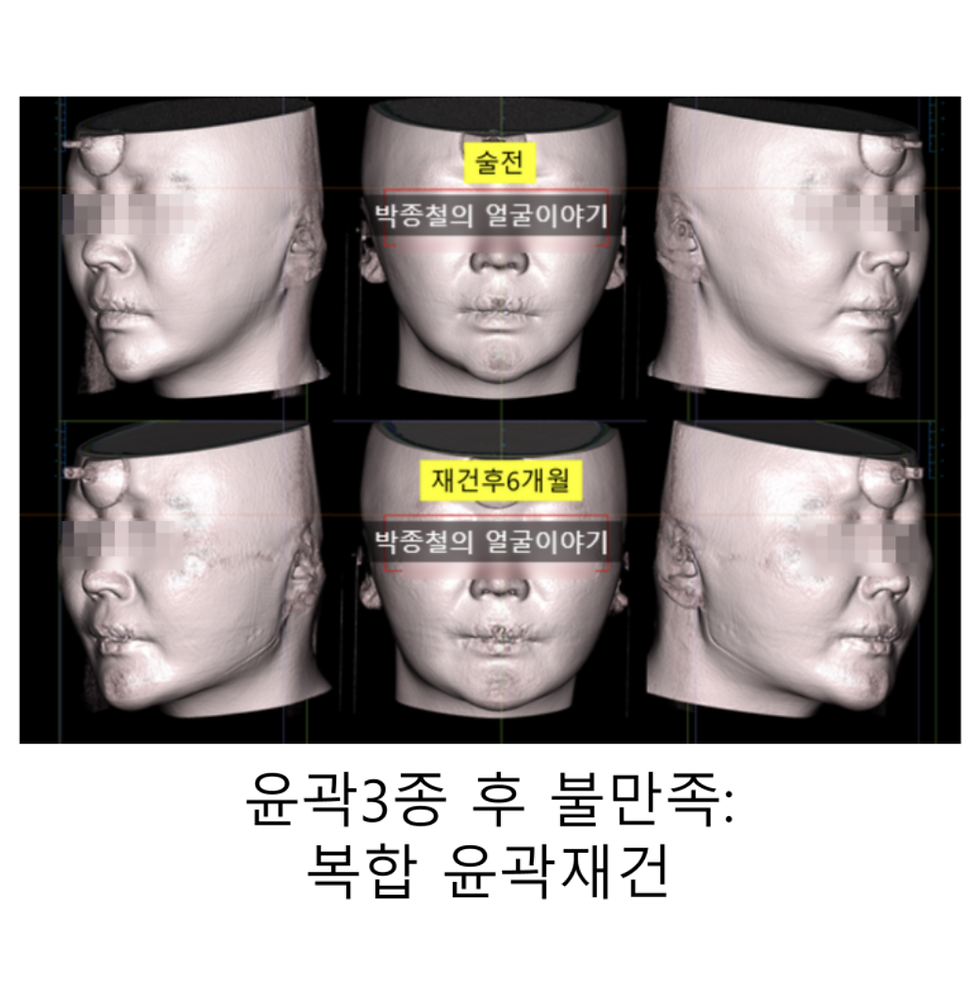Zygoma Revision Surgery: Implant vs. Bone Graft? A Surgeon's Comparison with Real Cases
- Dr. Park

- Oct 10
- 4 min read
Hello, I am Dr. Park Jong-cheol, an Oral and Maxillofacial Surgeon.
Following a zygoma reduction (cheekbone reduction surgery), a bone defect can sometimes occur at the osteotomy site due to incomplete bone union. For patients with thin skin, this area of bone loss can cause a visible indentation or a sunken appearance on the face.
When this occurs, zygoma revision surgery is required to restore or reconstruct the cheekbone contour. There are two primary methods to address this issue: reconstruction using a custom zygoma implant and restoration through zygoma repositioning combined with a bone graft.
Today, I will provide an objective comparison of the advantages and disadvantages of these two revision methods, using real cases that I have personally performed.


1. Zygoma Revision Surgery Using Custom Implants
The first method involves using 3D printing technology to create a custom-made implant that fits the patient's specific bone defect perfectly. Materials such as titanium, PEEK, or silicone are commonly used, and the implant is precisely designed based on pre-operative 3D CT data.
Advantages
Precision: Being 3D-printed, the implant is tailored to fit the defect area with exceptional accuracy.
Shorter Surgery Time: The procedure is relatively quick as it does not require bone harvesting or repositioning.
Predictable Results: The restoration is immediate, and the result is stable and permanent, with a low risk of changes in shape or volume over time.
Disadvantages
Foreign Body Reaction: As the implant is not the body's own tissue, there is a rare possibility of a foreign body reaction.
Image Distortion: Titanium implants may cause metal artifacts, which can distort future CT or MRI scans.
[Case Study] Reconstruction with a Zygoma Implant
This patient presented with a significant bone defect approximately 10mm wide after a previous zygoma reduction. To precisely correct this, a custom zygoma implant was designed through 3D modeling and inserted, successfully reconstructing a smooth and natural cheekbone contour.





2. Zygoma Revision Surgery Using Zygoma Repositioning and Bone Grafting
The second method involves performing a zygoma repositioning osteotomy, where the existing cheekbone is cut again and moved to a more ideal position. Any remaining bone defects are then filled with a bone graft. The graft can be autologous (the patient’s own bone, often from the lower jaw or hip) or allogeneic (processed donor bone).
Advantages
Biocompatibility: Over time, both autologous and allogeneic bone grafts integrate with and are replaced by the patient's own bone, making this a very biologically safe option.
Disadvantages
Potential for Bone Resorption: The grafted bone undergoes a natural physiological process called bone remodeling, which can lead to partial absorption. This may cause a slight difference between the planned volume and the final outcome.
Longer Surgery Time: The procedure is more complex due to the additional steps of repositioning and grafting the bone, which can increase the overall surgery time.
[Case Study] Restoration with Zygoma Repositioning and Allogeneic Bone Graft
In this case, zygoma repositioning was performed to expand the 45-degree (anterior) and lateral cheekbones to restore volume. The remaining defect was filled with an allogeneic bone graft. The 8-month post-operative 3D CT scan shows the bone defect was successfully regenerated with the patient's own bone, and the soft tissue volume was also naturally restored.


Conclusion: Which Zygoma Revision Method is Right for You?
To summarize, zygoma revision surgery using a zygoma implant offers high predictability and a simpler procedure but involves placing a foreign material in the body. In contrast, zygoma repositioning with bone grafting has the biological advantage of using one's own tissue for healing but must account for the variable of potential bone resorption.
Neither method is definitively superior to the other. The optimal choice depends on a comprehensive evaluation of the patient's specific condition, including the size and nature of the bone defect, the quality of the remaining bone, and the patient's long-term aesthetic goals.
Therefore, if you are considering zygoma revision surgery to correct a bone defect, it is essential to have a thorough consultation with an Oral and Maxillofacial Surgeon. A precise diagnosis using a 3D CT scan will allow for a surgical plan that is truly optimized for you.

Zygoma Revision Surgery



Comments